|
THE STORY OF KING KAMEHAMEHA |
Maui was the third island that
Marla and I had been to. Everywhere we went on
Oahu, the Big Island, and now Maui, I noticed I was
driving on "Kamehameha Highway" or "Kamehameha
Avenue" or "Kamehameha Boulevard". It seemed like everywhere I went in Hawaii, the name "Kamehameha"
kept popping up. I even noticed there was a
butterfly named after him.
It wasn't that big a deal when I saw the name
plastered throughout Honolulu, but now that it was
showing up on the other islands as well, the name
finally impinged upon my consciousness.
Finally I got curious. Maybe this "Kamehameha" guy
was somebody I needed to know about. So poked my nose into my handy
little Hawaiian History guide.
That is when I discovered that King Kamehameha
was the single most important figure in the history of these
islands. Kamehameha was such an excellent military
leader he was called the "Napoleon of the Pacific"...
except that he outweighed Napoleon by a couple hundred pounds.
Kamehameha (1737-1819) was indeed a very robust man. He
was also a very healthy man, living to the ripe old age
of 82 during an era where life spans topped out around 50. Kamehameha (pronounced
Ka May a May a) was the
man who united all the islands under one rule for the very first
time. This occurred over a twenty year period at roughly the same time as our American Revolution.
Kamehameha was both ruthless as well as benevolent. He was
said to be perpetually dour and very guarded. His name
translated into English means "The Lonely One". He got this
name for a reason.
Born of royal blood on the Big Island, Kamehameha was kept
hidden in the mountains of Hawaii for the first years of his life.
This was unusual treatment for a young prince, but it had been
foretold at his birth that he would be a killer of kings.
Consequently, his life was in danger for a long time from
those who wished to forestall his carrying out such a career.
When he was five, he was brought back to the court of Kalaniopuu,
his royal uncle, and given the feather helmet and cloak of a
nobleman.
|
 |
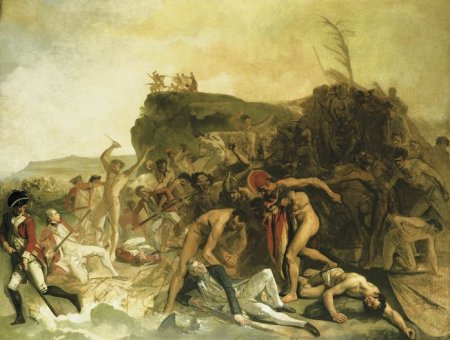 |
From this point on, Kamehameha began his
development as a warrior.
One of the important experiences of his life came
at age 40. In 1779, Captain James Cook pulled his ships into Kealakekua Bay on the Big Island,
which just happened to be Kamehameha's home. And that king
that Cook tried to kidnap as punishment
for the stolen boat was none other than Kalaniopuu himself
- Kamehameha's uncle and mentor. Therefore it very probable that
Kamehameha himself was on the scene when
Cook was killed.
As a close observer, Prince
Kamehameha may not have believed that Cook
was a god, but he certainly could see what an
advantage it was to possess the weapons and skills
of the Europeans had.
Kamehameha would put that knowledge to use in the
near future.
|
DEATH OF THE KING
At this time his uncle Kalaniopuu was
growing old. The Chief appointed
Kiwalao, his own son, as his heir to the kingdom. Kamehameha was
given the title of war chief, the next most important rank.
Kamehameha had
become second in command. Despite his status as a great
warrior, there is no account that Kamehameha
was involved in plots to advance his own career.
Instead he lived quietly on his own lands and took no part in
politics until the old king died in 1782 (three
years after Cook's death).
The new chief Kiwalao was a moderate man.
He was terrified that his ambitious brother, Keoua, would
cause trouble. As is often the case when a
king dies, there was an opportunity for a power grab. Seeing
that civil war was brewing, the other chiefs
of the island appealed to Kamehameha for support.
War did break out with the two brothers Kiwalao
and Keoua aligning
against Kamehameha and his other
chieftains. In the fierce fighting, almost immediately Kiwalao
was killed. The new king was dead. Who would rule now?
Keoua was declared king. For eight
years the war went on, always becoming more involved with the
complicated politics of the various islands.
Neither side, it seems, could get an advantage on the other. The two
kings were evently matched. Keoua had his side of the Big
Island, Kamehameha had the other side.
Kamehameha got the break he needed from an unexpected source.
European merchants decided great profits could be made carrying
cargoes of furs from what is now British Columbia over to China in
exchange for cargoes of tea. By stopping at Hawaii, a natural
mid-point for long Pacific voyage, the ships could take on fresh
food and water. One of these voyages, in 1787, a Hawaiian
chief named Kaima was taken along to China. He returned with
many presents which included muskets, ammunition, and a small
cannon.
This chief was persuaded - or blackmailed - into joining Kamehameha
and his followers. In this way, the war chief got control of the new
and powerful weapons he had first witnessed on the ships of James
Cook. Kamehameha was well aware of what these weapons could do
and immediately put them to use.
About this same time, Kamehameha acquired two valuable assistants.
It seems that one of his chiefs massacred the crew of an American
schooner in revenge for an insult. Only two men, John Young and
Isaac Davis, survived. Kamehameha at once made those two men
his allies by giving them the rank of chiefs with lands and
property. He now had not only weapons but now he had the
experts who knew how to handle them. He allowed Young and
Davis to train his warriors in their use.
MAUI AND THE BIG ISLAND
In the summer of 1790 Kamehameha invaded Maui, the island next to
Hawaii itself, and conquered it in a single battle. The
natives armed only with spears and clubs were no match against
muskets and cannon.
Any satisfaction over his military success on Maui was short-lived.
During Kamehameha's Maui campaign, Keoua had taken advantage of his
rival's absence and invaded Kamehameha's territory.
Furious, Kamehameha returned to the Big Island with a vengeance to
quell the uprising. Kamehameha received assistance from a most
unexpected source - the Volcano Goddess Pele!
Upon his return to Maui, Kamehameha quickly counterattacked and
drove Keoua back to Hilo. However the battle in Hilo was not
decisive, so both armies retreated.
Keoua headed back to his home district of Ka`u. The route to Ka`u
that Keoua and his troops chose was by way of Kilauea Volcano. Keoua
and his army started their march to Ka`u. On the first night
his army camped on Kilauea near a shrine dedicated to Pele, the fire
goddess. This was a period of volcanic activity at the Kilauea
caldera. Fearing they had somehow angered Pele, Keoua decided to
remain there for several days to bestow offerings in an attempt to
appease her.
Upon leaving Kilauea summit, Keoua split his army into three
different companies that left the crater at different intervals.
The first company had not gone far when the earth started to tremble
violently. Volcanic ash and hot gas exploded out of the caldera.
Then, a huge, dense cloud of ash, sand and rocks was ejected out of
the crater and rained down for miles around. Unable to escape, all
of the individuals in the second party died, mostly of suffocation
from the sulfurous gas.
Not far behind, the rear-company by chance survived the catastrophe
because they were not in the path of the hot ash. Picking themselves
up, they continued on their journey determined to get to Ka`u. They
were startled when they came upon members of the second company
lying down across the desert floor. There was not one
survivor. In a flash, Keoua had lost one-third of his army.
Not surprisingly, this broke the spirit of Keoua. How was he
supposed to beat Kamehameha now that Pele was aligned against him?
Demoralized, Keoua decided to negotiate. In 1791, he accepted
an invitation to visit Kamehameha for a discussion of peace on
Kamehameha's turf. Bad move.
As Keoua stepped ashore, one of Kamehameha's lieutenants took it
upon himself to throw a spear at the very first opportunity.
Keoua was able to dodge the spear, but not the musket fire that came
next. That ended the peace negotiations. Thanks to the
intervention of the Volcano Goddess Pele, Kamehameha had at last
succeeded in making himself ruler of all the Big Island.
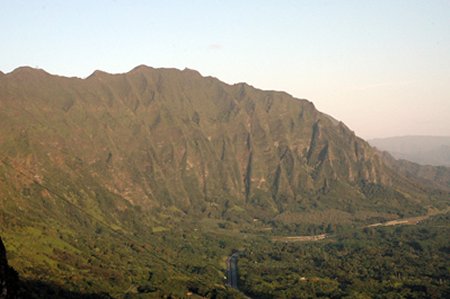 |
OAHU
This cliff is known as Nuuanu Pali.
This cliff figured prominently in one of the most brutal endings to
a battle ever recorded in military history.
This remarkable military story involved Kamehameha's campaign
against two formidable opponents - Kalanikupule, Chief of Oahu and
Kaiana, a defector from Kamehameha's ranks - on the island of Oahu.
In 1794, Kamehameha did the most curious thing - he ceded the
islands of Hawaii to Great Britain!
George Vancouver was in
constant negotiations with Kamehameha to join the British Empire.
|
Apparently England wasn't mad about Cook's
murder 15 years earlier. Let bygones be bygones, come join
the Empire!
On February 25, 1794, the King made a formal proclamation of
accession, declaring that his people were now "People of
Britain". This would prove to be a particularly smooth
move for Kamehameha.
In return for his promises, Kamehameha received assistance from
Vancouver that was particularly helpful. In addition to
more guns, Vancouver lent him tools and skilled workers to help
Kamehameha build him an armed 36-foot craft, the Britannia.
Oddly enough, in the following years Britain never once took
advantage of this pact. Advantage in deal: Kamehameha.
In 1795, Kamehameha and his army invaded Oahu, arriving in an
imposing fleet of war canoes at Waikiki Beach. Kamehameha
launched an invasion fleet of some 1,200 canoes and more than
10,000 warriors, amazing figures for this sparsely populated
area (at this time, the entire population of the Hawaiian
Islands was less than 300,000). He would need every one of
these men to succeed because his opponents had three advantages.
First, Kalanikupule knew Kamehameha was coming. He had
received prior warnings of the impending invasion from the
chiefs of Maui and Molokai and had begun building several lines
of powerful fortifications on Oahu.
Second, Kalanikupule was able to fight fire with fire. He had
already begun buying muskets and cannons from European traders.
Third, he was assisted by one of Kamehameha's former chiefs,
Kaiana, a defector. Kaiana had fallen out of favor with
Kamehameha's inner circle and feared that he was being plotted
against. His army was actually part of the armada that
attacked Oahu, but in a surprise move during the approach, his
army split off from the Hawaiian armada and landed on the north
side of the island. There they began cutting notches into the
Nu'uanu mountain ridge, which would serve as gunports for
Kalanikupule's cannons.
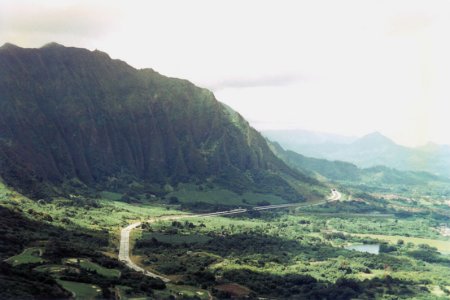 |
Kamehameha had more men and more guns, but the
coalition of Kaiana and Kalanikupule held the high ground.
Using his cannons like a Hawaiian version of the Guns of Navarone,
Kaiana was able to keep the superior force below pinned down.
In fact, the cannons were cutting Kamehameha's forces to shreds.
Showing tremendous military acumen, Kamehameha made two
strategic moves. Kamehameha's army advanced westward,
encountering Kalanikupule's first line of defense near the Punchbowl
Crater. Splitting his army into two, Kamehameha sent one half in a
flanking maneuver around the crater and the other straight at
Kalanikupule. Pressed from both sides, the Oahu forces
retreated to Kalanikupule's next line of defense near Laimi.
|
But until those mountain cannons were
silenced, Kamehameha's attack was stifled. Kamehameha
secretly detached a portion of his army to climb some undefended
sheer cliffs. This climb was made very near to the heights
of the Nuuanu Valley where Kalanikupule's cannons were located.
In this manner, the commandos were able to sneak up behind the
stronghold and butcher the stunned artillerymen.
As usual, Kamehameha enjoyed another amazing stroke of luck when
his cannons took out both of the enemy leaders. Using the
armaments that George Vancouver had given him, Kamehameha
brought up his own cannons to shell Laimi. During this
part of the battle, Kalanikupule was badly wounded and Kaiana
was killed. Stripped of their powerful cannons and both
commanders, now the resistance weakened considerably. With
its leadership in chaos, the Oahu army slowly fell back north
through the Nu'uanu Valley to the cliffs at Nu'uanu Pali.
Yes, it is ridiculous that the random cannon fire was able to
take out both leaders (1,000 to one odds?), but it seems to me
Kamehameha was also the benefactor of that old saying,
'the harder I work, the luckier I get'.
Vancouver's guns made a huge difference in Kamehameha's decisive
win at Battle of Nuuanu, but then who made the deal with
Vancouver?
The ensuing battle was fierce, bloody and unrelenting.
Gradually, Kamehameha’s men gained an advantage, forcing
Kalanikupule’s forces to retreat even further up the valley.
Now the men were trapped. At their backs
was a cliff that dropped a thousand feet. They were fighting
for their lives!
The Oahuans attempted to make a final stand, but Kamehameha’s
army was too strong. Then came the final remarkable moment.
The final 400 fleeing warriors were pushed or jumped to their deaths
off the 1,200-foot Nuuanu Pali.
It is said that the victory was so complete that not a single
Oahu warrior escaped alive.
Kamehameha had conquered Oahu. With it came the neighboring
islands of Lanai and Maui.
|
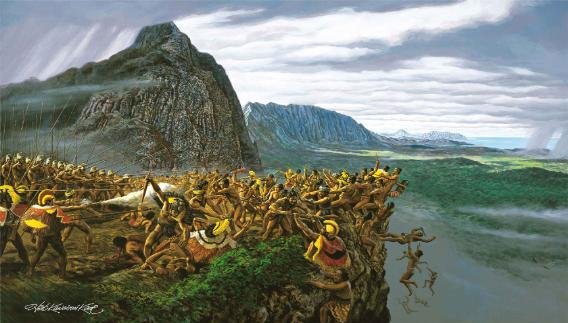 |
KAUAI AND THE LATER
YEARS
During the reign of King Kamehameha, the
islands of Kauai and Niihau were the last Hawaiian Islands to
join his Kingdom of Hawaii. Their ruler, Kaumualii, had
successfully resisted Kamehameha for years. King
Kamehameha twice prepared a huge armada of ships and canoes to
take the islands by force and twice had failed; once due to a
storm, and once due to an epidemic.
Meanwhile American and European merchants who did not want
warfare to disrupt the lucrative sandalwood trade finally
persuaded Kauai ruler Kaumualii to acknowledge Kamehameha as
sovereign. Their persuasion combined with the threat of
further invasion eventually wore down his will.
Kaumualii decided to join the kingdom without bloodshed, thereby
becoming Kamehameha's vassal in 1810. Kamehameha, in turn,
permitted Kaumualii to govern the island until his death.
Kaumualii ceded the island to the Kingdom of Hawaii upon his
death.
It took him nearly 30 years, but Kamehameha had finally created
his empire. The many islands were now united.
Ultimately he had succeeded because he allied himself with the
Europeans who chose to back him. Their armaments made the
difference in every battle. Of all Kamehameha's abilities,
it was his resourcefulness in dealing with foreigners that
inspired the most admiration. Kamehameha viewed his
"friends" as the necessary evil it took to gain his kingdom.
Throughout his years, he had a remarkable ability to keep the
Europeans at arm's length. In his dealings with white men,
he was never their servant but always their master.

The Ravages of Leprosy |
Or at least so he thought.
Unfortunately Kamehameha's friends took this
island nation down a very dark path. The foreign merchants
coveted Hawaii's valuable forests of sandalwood trees, a source of
fragrant oil very popular in China for use as incense. The foreigners persuaded
landowners not only to ruin forests that had taken centuries to
form, but to neglect their own crops in the process so they could
help them cut down more trees. Unbelievably, the sandalwood
economy led to famine!
In return for the valuable sandalwood, they traded guns and rum.
The population was soon hooked on this tasty drink. What they
didn't know was that soon the rum would lay waste to the health of
thousands of natives.
Even worse, the foreigners introduced horrible diseases into a
populace which had absolutely no immunity. Thanks to imported
diseases such as pneumonia, leprosy, smallpox, measles, syphilis,
and gonorrhea, the population was decimated by one half. In
1804 half of the Hawaiian population was
wiped out by the Black Plague or Cholera.
In just 26 years after first contact with Europeans, the Hawaiian
population had shrunk from an estimated 300,000 to 150,000. With
friends like these, who needs enemies? The foreigners were
busy doing
to the Hawaiians what the white man did to the American Indian.
Alcohol, disease, constant death, and ruined forests were the price
Kamehameha paid to pave his road to destiny. In the end, it
surely must have seemed like a devil's bargain indeed.
Hawaii's Age of Innocence was clearly over.
After the unification of Hawaii, Kamehameha would only live for 9
more years. Faced with this kind of horror, who could blame
him for moving on?
|
|
|
|
|
MAUI'S FAMOUS ROAD TO HANA
|
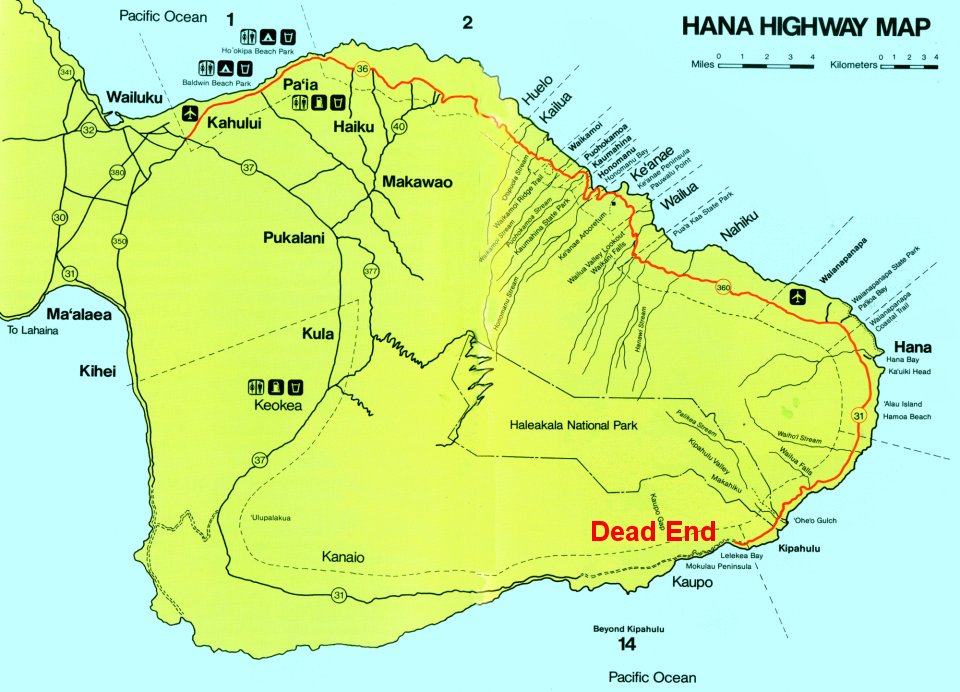 |
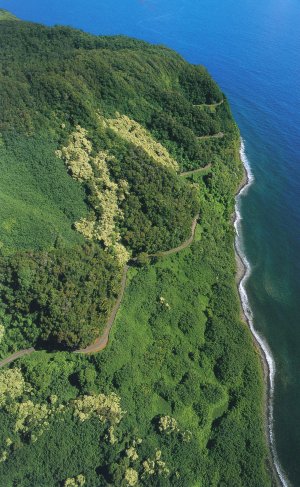 |
Maui's Road to Hana is world famous for the natural
beauty of its unblemished landscapes and towering waterfalls.
Maui is understandably proud of
Hana's successful fight against overdevelopment and the destruction
of their Hawaiian culture.
Whoever said, "Life is about the journey,
not the destination", probably had this
fascinating drive in mind.
One thing you should agree to do is give yourself
plenty of time. Hana Highway -- with its 54 one-lane bridges
and slithering 52-mile course -- has already made the message clear
that you aren't going to get anywhere quickly.
In addition to the one-lane bridges that bring progress to a
complete standstill, there is practically no way to pass people without endangering life.
You find yourself at the mercy of the slowest turtle on the
road...so sit back, relax, and enjoy the ride!
If Marla and I had to do it over again, we would have bought one of
those Road to Hana Audio Books that serve as a type of
narration as you roll down the highway. Instead we settled for
a couple of books that basically were undecipherable.
The entire route of the Road to Hana hugs the ocean.
It owes its curvy design to the fact that this entire side of the
island is basically one giant volcano - Haleakala.
The letter of the Alphabet that best describes the Road to Hana is
the letter S. "S" as in Slow,
Snaky, Swervy, and
Sublime. As you can see from the picture, this road hugs the
coastline in a never-ending series of S-Turns. Years of
erosion have created constant gaps in the rock, so the road winds in
and out, in and out.
|
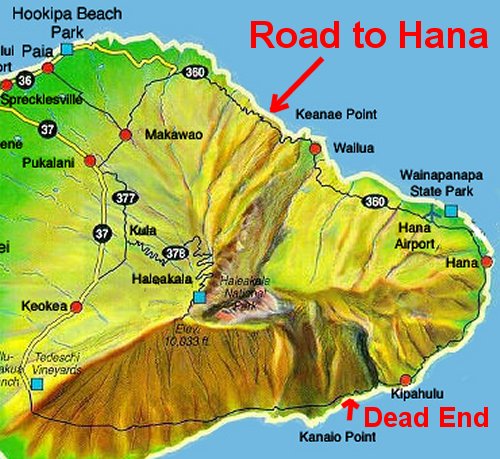 |
This map indicates the road completely
encircles the volcano, but that is deceiving. The road
on the rugged southern side of East Maui is open to special
4-wheel drive, all-terrain vehicles only.
They say 99% of all
vehicles turn around and head back after visiting the lush Kipahulu area (which serves as the biggest highlight of the
trip).
However I read one web site that indicates this "Forbidden
Route" may be one of Maui's best kept secrets.
Apparently the road is in better condition than they say it
is, but the locals prefer to reserve the route for
themselves, not the crazy day-trippers like us.
That said, there is a rumor out that the Forbidden Road
offers a much-swifter return to the center of the Island for
three reasons - no traffic, no one-way bridges, and a
shorter distance.
Too bad I didn't know this insider's tip the day Marla and I
went - I would have been sorely tempted to give it a try.
They say there are two kinds of vehicles that can go
anywhere - ATVs and rental cars. hahaha
|
|
If you study the two maps, you will see that the lava flowed from
the top in two major directions. The largest flow
headed towards Wailua on the north side. Whenever it
rains in Maui - which is all the time - a tremendous amount
of the water flows through this low-lying area. As a
result, there is a never-ending number of beautiful
waterfalls that can be seen as you drive along.
Another significant lava flow went
south to Kipahulu. Since
this flow area is steeper and narrower, the rainwater takes
a faster, more concentrated path to the ocean. This
explains why this area has such fascinating scenery.
The waterfalls in the Kipahulu region are very tall, thick, and
quite spectacular. And there are many beautiful water pools
that invite you to wade in
them.
This is the place Marla and I wanted to visit the
most.
|
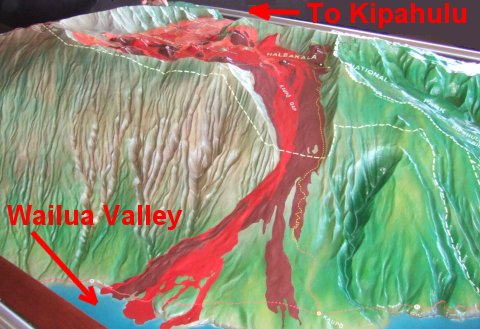 |
You see, Marla and I went slightly
nuts on this trip. We were desperate to see the Seven Sacred Pools
in Ohe'o Gulch area (pictured at right) at the very end of
the road, but we had no idea how much time it took to get
there. We had no way to make progress because the road
does not allow you pass anyone without risking your life.
Apparently city slickers like Marla and I aren't
the only ones who have emotional problems dealing with the slow
pace. Like us, it seems most Hana visitors can't bear the
turtle crawl down the highway.
Dubbed "whizzers" by the locals, these people just come for the day.
Upon reaching Hana, typically after driving three hours, they're
already calculating how long it will take to whiz back out.
The problem is there is so much to see, you really need a few days,
not a few hours, to appreciate this area.
|
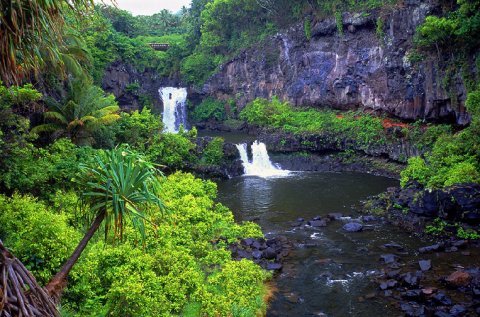 |
|
Be that as it may, sometimes whether you like it
or not, you have to obey the demands of the almighty clock. My
memory is that on this day we had to return our car and be back on
the ship by 5 pm. We had made a solemn
vow that wherever we were at the halfway point time-wise, we were
going to turn around. Leaving at 11 am, Marla and I were only able
to make it as far as Hana at 2 pm. We were tempted to go
further. Like a great movie, we knew the Road to Hana had
saved the very best for last... 8 miles further down the road.
Every wishbone in our body was screaming for us to keep
driving to
Haleakala National
Park in an area known as Kipahulu. Here we would be treated to
the beauty of the Seven Sacred Pools, the Makahiku
Falls (pictured at right), the
Ohe'o Gulch, and the Waimoku Falls.
Ohe'o Gulch is one of the major sightseeing
attractions on a trip to Hana. When you have made all the way to
Hana, it is surely worth it to drive ten more miles. The Kipahulu
Valley is part of the Haleakala National Park, and there is a
Visitor Center at the parking lot.
Waimoku Falls Trail and Ohe'o Gulch are separated only by the
street. A visit to Oheo Gulch is a stroll of 30 minutes on a paved
way, while a hike to Waimoku Falls and back takes approximately
one and a half hours.
The Pipiwai Trail, which is located above the Seven Sacred
Pools, is one of the best hikes on Maui. It is 4 miles
roundtrip, gaining 650-feet in elevation. It takes 2 1/2 - 5
hours to hike, depending on how much nature loving you do. There are
several great waterfalls along the route with the final destination
being Waimoku Falls, falling 400-feet down a sheer lava rock wall.
And we missed it!
Oh no!
|
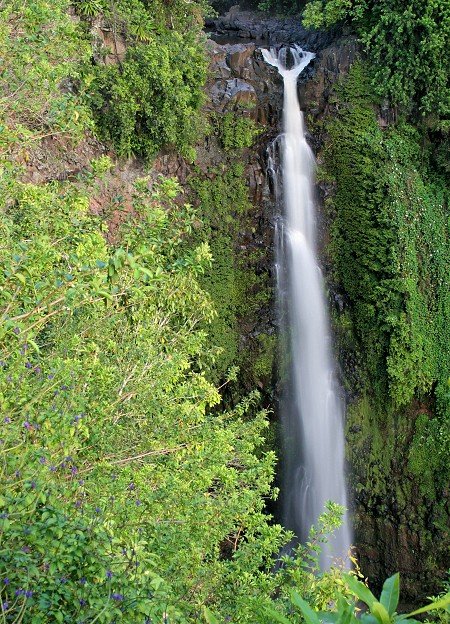 |
Oheo Gulch (pictured at right) is made up of many
waterfalls and pools, one leading into the other. Conditions
allowing, it can be a fantastic place to swim. The pools are of
varying sizes and elevations, and lead straight out to the ocean.
And we missed it!I kept doing the math. This wonderful area was
8 miles
past Hana. Just 8 itty bitty little miles. Here in
Houston on a good day that would be 10 minutes, right? Not the
Road to Hana. Eight miles could be another hour at the rate we
were going.
For the first time in my adult life I showed maturity and
headed back to the ship. Well, I guess I will admit the truth
- Marla made me turn back. Someone has to be the adult.
But it nearly broke my heart to turn back. To this day, Marla
and I still sick about missing this spot.
|
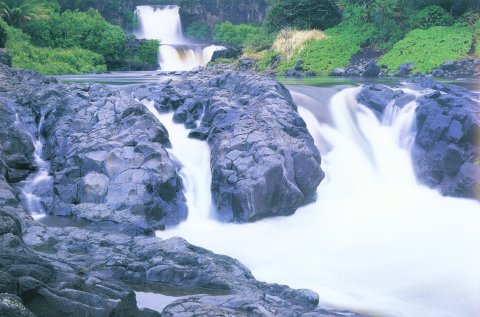 |
Our disappointment aside, all in all, Marla and I agreed
without a doubt Maui was our favorite island. Below I have
listed four more spots we didn't even come close to
seeing (much to my chagrin).
- Waianapanapa
State
Park
- Kahakuloa
Head
-
Iao Needle
-
Makena
Beach
These Hawaiian Islands are
called the closest thing to Paradise for a reason.
There is so much beauty to be seen everywhere.
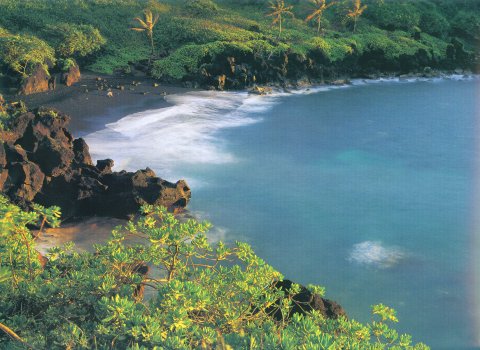
Waianapanapa
State Park
|

Kahakuloa Head
|
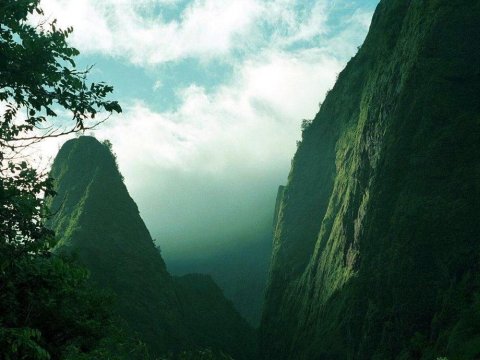
Iao Needle |
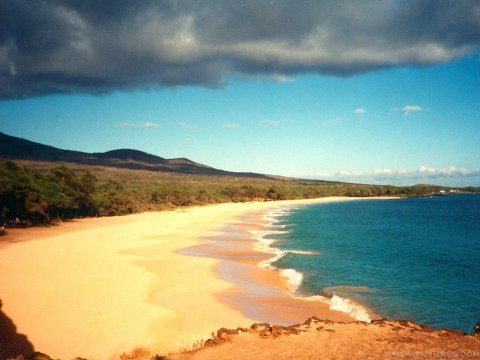
Makena Beach |
|